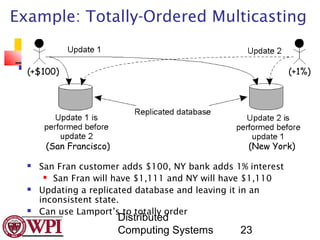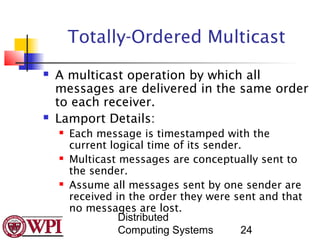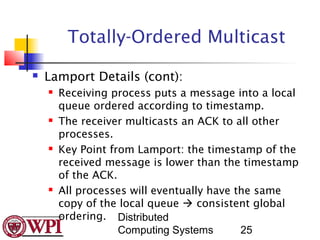Synch
- 1. Synchronization Part 1 REKŌĆÖs adaptation of ClaypoolŌĆÖs adaptation of TanenbaumŌĆÖs Distributed Systems Chapter 5 1
- 2. Outline ’ü« Clock Synchronization ’ü« Clock Synchronization Algorithms ’ü« Logical Clocks ’ü« Election Algorithms ’ü« Mutual Exclusion ’ü« Distributed Transactions ’ü« Concurrency Control Distributed Computing Systems 2
- 3. Clock Synchronization make example ’ü« When each machine has its own clock, an event that occurred after another event may nevertheless be assigned an earlier time. ŌĆó Same holds when using NFS mount ŌĆó Can all clocks in a distributed system be synchronized? Distributed Computing Systems 3
- 4. Physical Clocks ’ü« It is impossible to guarantee that crystals in different computers all run at exactly the same frequency. This difference in time values is clock skew. ’ü« ŌĆ£ExactŌĆØ time was computed by astronomers ’ü« The difference between two transits of the sun is termed a solar day. Divide a solar day by 24*60*60 yields a solar second. ’ü« However, the earth is slowing! (35 days less in a year over 300 million years) ’ü« There are also short-term variations caused by turbulence deep in the earthŌĆÖs core. ’ü« A large number of days (n) were used used to the average day length, then dividing by 86,400 to determine the mean solar second. Distributed Computing Systems 4
- 5. Physical Clocks Computation of the mean solar day. Distributed Computing Systems 5
- 6. Physical Clocks ’ü« Physicists take over from astronomers and count the transitions of cesium 133 atom ’ü« 9,192,631,770 cesium transitions == 1 solar second ’ü« 50 International labs have cesium 133 clocks. ’ü« The Bureau Internationale de lŌĆÖHeure (BIH) averages reported clock ticks to produce the International Atomic Time (TAI). ’ü« The TAI is mean number of ticks of cesium 133 clocks since midnight on January 1, 1958 divided by 9,192,631,770 . Distributed Computing Systems 6
- 7. Physical Clocks ’ü« To adjust for lengthening of mean solar day, leap seconds are used to translate TAI into Universal Coordinated Time (UTC). ’ü« UTC is broadcast by NIST from Fort Collins, Colorado over shortwave radio station WWV. WWV broadcasts a short pulses at the start of each UTC second. [accuracy 10 msec.] ’ü« GEOS (Geostationary Environment Operational Satellite) also offer UTC service. [accuracy 0.5 msec.] Distributed Computing Systems 7
- 8. Outline ’ü« Clock Synchronization ’ü« Clock Synchronization Algorithms ’ü« Logical Clocks ’ü« Election Algorithms ’ü« Mutual Exclusion ’ü« Distributed Transactions ’ü« Concurrency Control Distributed Computing Systems 8
- 9. Clock Synchronization Algorithms ’ü« Computer timers go off H times/sec, and increment the count of ticks (interrupts) since an agreed upon time in the past. ’ü« This clock value is C. ’ü« Using UTC time, the value of clock on machine p is C p(t). ’ü« For a perfect time, Cp(t) = t and dC/dt = 1. ’ü« For an ideal timer, H =60, should generate 216,000 ticks per hour. Distributed Computing Systems 9
- 10. Clock Synchronization Algorithms ’ü« But typical errors, 10ŌĆō5, so the range of ticks per second will vary from 215,998 to 216,002. ’ü« Manufacturer specs can give you the maximum drift rate (Žü). ’ü« Every Ōłåt seconds, the worst case drift between two clocks will be at most 2ŽüŌłåt. ’ü« To guarantee two clocks never differ by more than ╬┤, the clocks must re-synchronize every ╬┤/2Žü seconds using one of the various clock synchronization algorithms. Distributed Computing Systems 10
- 11. Clock Synchronization Algorithms ’ü« Centralized Algorithms ’ü« CristianŌĆÖs Algorithm (1989) ’ü« Berkeley Algorithm (1989) ’ü« Decentralized Algorithms ’ü« Averaging Algorithms (e.g. NTP) ’ü« Multiple External Time Sources Distributed Computing Systems 11
- 12. Cristian's Algorithm ’ü« Assume one machine (the time server) has a WWV receiver and all other machines are to stay synchronized with it. ’ü« Every ╬┤/2Žü seconds, each machine sends a message to the time server asking for the current time. ’ü« Time server responds with message containing current time, CUTC. Distributed Computing Systems 12
- 13. Cristian's Algorithm Getting the current time from a time server Distributed Computing Systems 13
- 14. Cristian's Algorithm ’ü« A major problem ŌĆō the client clock is fast ’ā© arriving value of CUTC will be smaller than clientŌĆÖs current time, C. ’ü« What to do? ’ü« One needs to gradually slow down client clock by adding less time per tick. Distributed Computing Systems 14
- 15. CristianŌĆÖs Algorithm ’ü« Minor problem ŌĆō the one-way delay from the server to client is ŌĆ£significantŌĆØ and may vary considerably. ’ü« What to do? ’ü« Measure this delay and add it to CUTC. ’ü« The best estimate of delay is (T1 ŌĆō T0)/2. ’ü« In cases when T1 ŌĆō T0 is above a threshold, then ignore the measurement. {outliers} ’ü« Can subtract off I (the server interrupt handling time). ’ü« Can use average delay measurement or relative latency (shortest recorded delay). Distributed Computing Systems 15
- 16. The Berkeley Algorithm a) The time daemon asks all the other machines for their clock values. b) The machines answer and the time daemon computes the average. c) The time daemon tells everyone how to adjust their clock. Distributed Computing Systems 16
- 17. Averaging Algorithms ’ü« Every R seconds, each machine broadcasts its current time. ’ü« The local machine collects all other broadcast time samples during some time interval, S. ’ü« The simple algorithm:: the new local time is set as the average of the value received from all other machines. Distributed Computing Systems 17
- 18. Averaging Algorithms ’ü« A slightly more sophisticated algorithm :: Discard the m highest and m lowest to reduce the effect of a set of faulty clocks. ’ü« Another improved algorithm :: Correct each message by adding to the received time an estimate of the propagation time from the ith source. ’ü« extra probe messages are needed to use this scheme. ’ü« One of the most widely used algorithms in the Internet is the Network Time Protocol (NTP). ’ü« Achieves worldwide accuracy in the range of 1-50 msec. Distributed Computing Systems 18
- 19. Outline ’ü« Clock Synchronization ’ü« Clock Synchronization Algorithms ’ü« Logical Clocks ’ü« Election Algorithms ’ü« Mutual Exclusion ’ü« Distributed Transactions ’ü« Concurrency Control Distributed Computing Systems 19
- 20. Logical Clocks ’ü« For a certain class of algorithms, it is the internal consistency of the clocks that matters. The convention in these algorithms is to speak of logical clocks. ’ü« Lamport showed clock synchronization need not be absolute. What is important is that all processes agree Distributed on the order Computing Systems occur. in which events 20
- 21. Lamport Timestamps [1978] ’ü« Lamport defined a relation ŌĆØhappens beforeŌĆØ. a ’āĀ b ŌĆśa happens before bŌĆÖ. ’ü« Happens before is observable in two situations: 1. If a and b are events in the same process, and a occurs before b, then a ’āĀ b is true. 2. If a is the event of a message being sent by one process, and b is the event of the message being received by another process, then a ’āĀ b is also true. Distributed Computing Systems 21
- 22. Lamport Timestamps (impossible) a) Each processes with own clock with different rates. b) Lamport's algorithm corrects the clocks. c) Can add machine ID to break ties Distributed Computing Systems 22
- 23. Example: Totally-Ordered Multicasting (+$100) (+1%) (San Francisco) (New York) ’ü« San Fran customer adds $100, NY bank adds 1% interest ’ü« San Fran will have $1,111 and NY will have $1,110 ’ü« Updating a replicated database and leaving it in an inconsistent state. ’ü« Can use LamportŌĆÖs to totally order Distributed Computing Systems 23
- 24. Totally-Ordered Multicast ’ü« A multicast operation by which all messages are delivered in the same order to each receiver. ’ü« Lamport Details: ’ü« Each message is timestamped with the current logical time of its sender. ’ü« Multicast messages are conceptually sent to the sender. ’ü« Assume all messages sent by one sender are received in the order they were sent and that no messages are lost. Distributed Computing Systems 24
- 25. Totally-Ordered Multicast ’ü« Lamport Details (cont): ’ü« Receiving process puts a message into a local queue ordered according to timestamp. ’ü« The receiver multicasts an ACK to all other processes. ’ü« Key Point from Lamport: the timestamp of the received message is lower than the timestamp of the ACK. ’ü« All processes will eventually have the same copy of the local queue ’āĀ consistent global ordering. Distributed Computing Systems 25

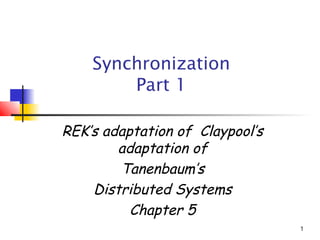

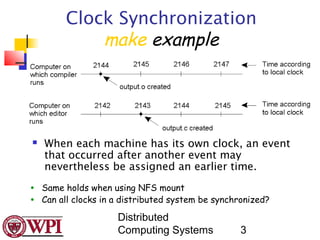
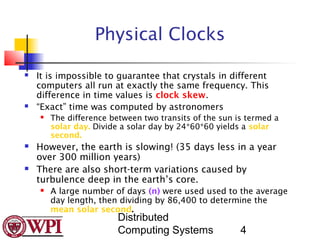
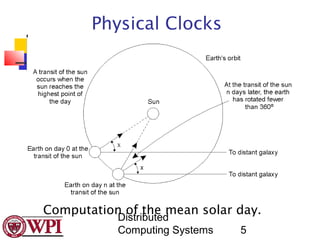
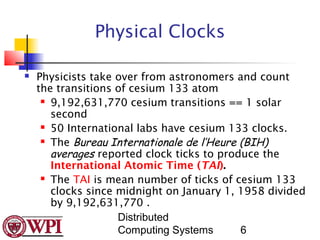
![Physical Clocks
’ü« To adjust for lengthening of mean solar day,
leap seconds are used to translate TAI into
Universal Coordinated Time (UTC).
’ü« UTC is broadcast by NIST from Fort Collins,
Colorado over shortwave radio station WWV.
WWV broadcasts a short pulses at the start
of each UTC second. [accuracy 10 msec.]
’ü« GEOS (Geostationary Environment
Operational Satellite) also offer UTC service.
[accuracy 0.5 msec.]
Distributed
Computing Systems 7](https://image.slidesharecdn.com/synch-130411082433-phpapp02/85/Synch-7-320.jpg)
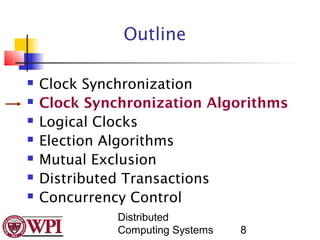

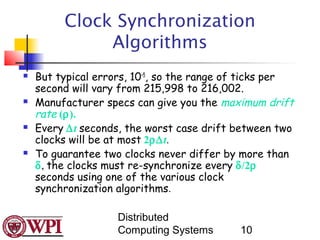
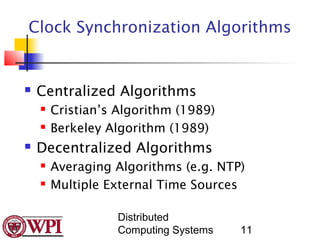
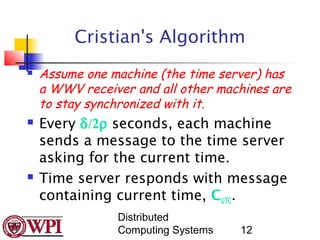


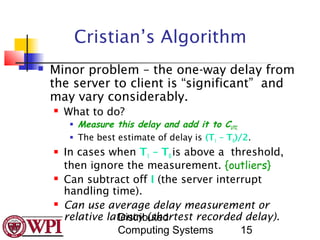
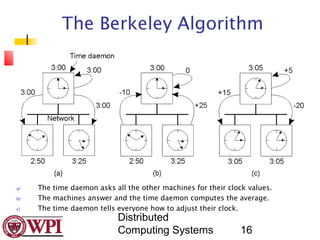
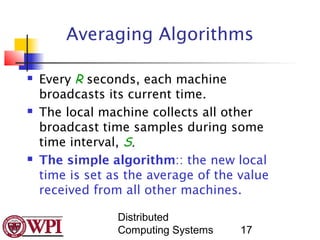
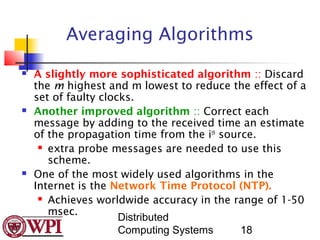
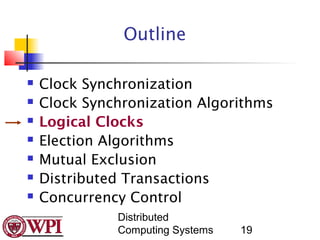
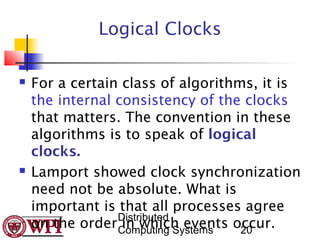
![Lamport Timestamps [1978]
’ü« Lamport defined a relation ŌĆØhappens
beforeŌĆØ. a ’āĀ b ŌĆśa happens before bŌĆÖ.
’ü« Happens before is observable in two
situations:
1. If a and b are events in the same process,
and a occurs before b, then a ’āĀ b is true.
2. If a is the event of a message being sent
by one process, and b is the event of the
message being received by another
process, then a ’āĀ b is also true.
Distributed
Computing Systems 21](https://image.slidesharecdn.com/synch-130411082433-phpapp02/85/Synch-21-320.jpg)

